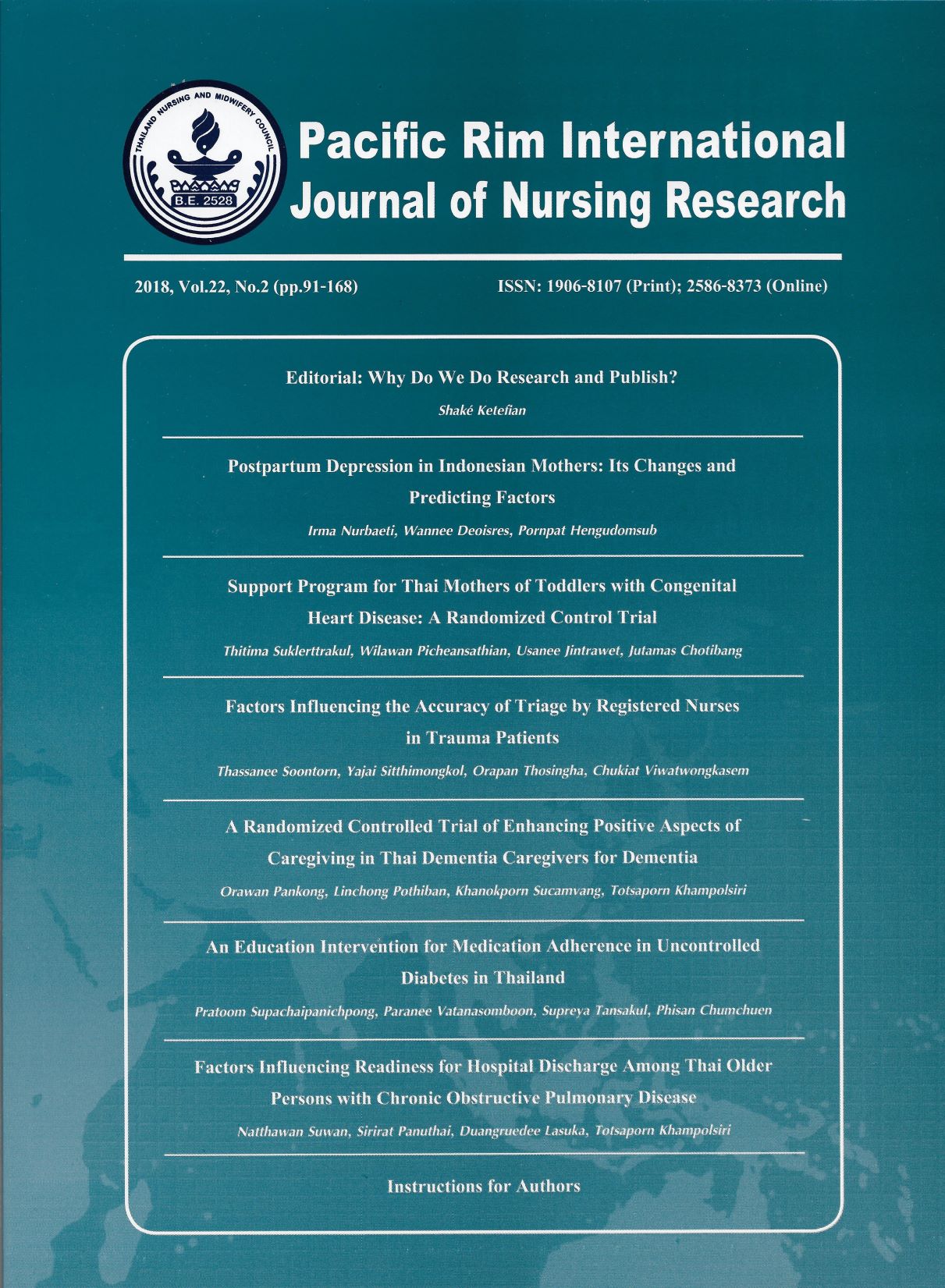Factors Influencing the Accuracy of Triage by Registered Nurses in Trauma Patients
Keywords:
Accuracy Triage, Emergency Care, Patients with Trauma, Registered Nurses, ThailandAbstract
An accuracy of triage in patients with trauma at the emergency department can assist them to receive appropriate treatment in time leading to decreased mortality and disability. The objectives of this study were to assess the accuracy of triage performed by registered nurses in the emergency department and examine factors influencing the triage accuracy in patients with trauma. A prospective observational design was performed in five emergency departments of regional hospitals in southern Thailand. The sample comprised 109 registered nurses and 1,090 adult patients with trauma. The accuracy of triage was calculated by using the difference score between the triage coding identified by a triage nurse immediately on patient emergency department arrival and the triage coding identified using the Emergency Severity Index Manual (Version 4). Multiple multinomial logistic regressions were employed to examine the predictors of triage accuracy.
Only 52.4% of patients were categorized into an accurate triage group. Years of work by participants in the emergency department increased the likelihood of over-triage. In terms of patient characteristics, patients with blunt injury, multiple injuries and altered consciousness were more likely to be over triaged. These data provide strong evidence to support the implementation of the Emergency Severity Index version 4 as a standard tool in the emergency department during triage. Such a policy would contribute to improving the accuracy of the triage level designation in patients with trauma receiving service from an emergency department.
References
2. Baebee G, Cristóbal SB-C, Marc LD, Jeffrey O, Steven G. The effect of provider level triage in a military treatment facility emergency department. J Emerg Prim Health Care. 2014;8(4).
3. Cameron AP, Gabbe JB, Smith K, Mitra B. Triaging the right patient to the right place in the shortest time. B J Anaesth. 2014;113(2):226-33.
4. Chen SS, Chen JC, Ng CJ, Chen PL, Lee PH, Chang WY. Factors that influence the accuracy of triage nurses’ judgement in emergency departments. Emerg Med J. 2010;27(6):451-5.
5. Esmailian M, Zamani M, Azadi F, Ghasemi F. Inter-rater agreement of emergency nurses and physicians in Emergency Severity Index (ESI) triage. Emerg. 2014;2(4):158-61.
6. Fathoni M, Sangchan H, Songwathana P. Relationships between triage knowledge, training, working experiences and triage skills among emergency nurses in East Java, Indonesia. Nurse Media Journal of Nursing. 2013; 3(1):511-25.
7. Göransson KE, Ehrenberg A, Marklund B, Ehnfors M. Emergency department triage: Is there a link between nurses’ personal characteristics and accuracy in triage decisions? Accid Emerg Nurs. 2006;14(2):83-8.
8. Weber JM, Jablonski RA, Penrod J. Missed opportunities: under-detection of trauma in elderly adults involved in motor vehicle crashes. J Emerg Nurs. 2010;36:6-9.
9. Lehmann R, Beekley A, Casey L, Salim A, Martin M. The impact of advanced age on trauma triage decisions and outcomes: a statewide analysis. Am J Surgery. 2009; 197(5):571-75.
10. Jordi K, Grossmann F, Gaddis GM, Cignacco E, Denhaerynck K, Schwendimann R, Nickel CH. Nurses’ accuracy and self-perceived ability using the Emergency Severity Index triage tool: a cross-sectional study in four Swiss hospitals. Scand J Trauma Resusc Emerg Med. 2015;23(62).
11. Saelim P. Evaluation of quality of Emergency Severity Index triage system. 12th Region Medical Journal. 2013; 24(1):1-7.
12. Shelton R. The Emergency Severity Index 5-level triage system. Dimens Crit Care Nurs. 2009;28(1):9-12.
13. Gardner G, Gardner A, Connell JO. Using the Donabedian framework to examine the quality and safety of nursing service innovation. J Clin Nurs. 2013;23:145-55.
14. Liu SW, Singer SJ, Sun BC, Camargo CA. A conceptual model for assessing quality of care for patients boarding in the emergency department: Structure-Process-Outcome. Acad Emerg Med. 2011;18(4):430-5.
15. Ryoko T, Masahiro S, Scott R. Framework development for the assessment of interprofessional teamwork in mental health settings. J Interprof Care. 2017;31(1):43-50.
16. Donabedian A. Evaluating the quality of medical care. The Milbank Quatterly. 2005;83(3): 691-729.
17. Bergs J, Verelst S, Gillet J-B, Vandijck D. Evaluating implementation of the Emergency Severity Index in a Belgian hospital. J Emerg Nurs. 2014;40:592-7.
18. Storm-Versloot MN, Ubbink DT, Chin a Choi V, Luitse JS. Observer agreement of the Manchester Triage System and the Emergency Severity Index: a simulation study. Emerg Med J. 2009;26(8):556-60.
19. National Institute for Emergency Medicine. Practice guidelines and implementations for triage in emergency patients and prioritization in the emergency room accordance with the NIEM principle. Thailand; 2013.(in Thai)
20. Gilboy N, Tanabe P, Travers D, Rosenau AM. Emergency Severity Index (ESI): a triage tool for emergency department care version 4. Agency for Healthcare Research and Quality: Rockville; 2012.
21. Shafizadeh S, Tjardes T , Steinhausen E , Balke M, Paffrath T, Bouillon B, et al. Advanced Trauma Life Support (ATLS) in the emergency room. Is it suitable as an SOP? Orthopäde. 2010;39:771-6.
22. Tsang B, McKee J, Engels TP, Paton-Gay D, Widder LS. Compliance to advanced trauma life support protocols in adult trauma patients in the acute setting. World J Emerg Surg. 2013;8(39).
23. Cotte J., Courjon F., Beaume S., Prunet B., Bordes J., N’Guyen C. et al. Vittel criteria for severe trauma triage: Characteristics of over-triage. Anaesth Crit Care Pain Med. 2016; 35: 87–92.
24. Velmahos GC, Degiannis E, Doll D. Penetrating trauma: a practical guide on operative technique and peri-operative management: Springer Berlin Heidelberg; 2011.
25. Haider AH, Chang DC, Haut ER, Cornwell EE, Efron DT. Mechanism of injury predicts patient mortality and impairment after blunt trauma. J Surg Res. 2009; 153(1):138-42.
26. Burack JH, Kandil E, Sawas A, O’Neill PA, Sclafani SJA, Lowery RC, Zenilman ME. Triage and outcome of patients with mediastinal penetrating trauma. Ann Thorac Surg. 2007;83(2):377-82.
27. Nakahara S, Matsuoka T, Ueno M, Mizushima Y, Ichikawa M, Yokota J, Yoshida K. Predictive factors for undertriage among severe blunt trauma patients: What enables them to slip through an established trauma triage protocol? J Trauma Acute Care Surg. 2010;68(5):1044-51.
28. Ross SE, Leipold C, Terregino C, O’Malley KF. Efficacy of the motor component of the Glasgow Coma Scale in trauma triage. J Trauma Acute Care Surg. 1998; 45(1): 42-4.
29. Negoi I, Paun S, Hostiuc S, Stoica B, Tanase I, Negoi R I, et al. Mortality after acute trauma: progressive decreasing rather than a trimodal distribution. J Acute Dis. 2015; 4(3):205-9.
30. Eftekhar B, Zarei MR, Ghodsi M, MoezArdalan K, Zargar M, Ketabchi E. Comparing logistic models based on modified GCS motor component with other prognostic tools in prediction of mortality: results of study in 7226 trauma patients. Injury. 2005;36(8):900-4.
31. Levin HS, Diaz-Arrastia RR. Diagnosis, prognosis, and clinical management of mild traumatic brain injury. The Lancet Neurology. 2015;14(5):506-17.
32. Werman HA, Erskine T, Caterino J, Riebe JF, Valasek T. Development of statewide geriatric patients trauma triage criteria. Prehosp Disaster Med. 2011;26(3):170-9.
33. Dinh MM, Bein KJ, Oliver M, Veillard AS, Ivers R. Refining the trauma triage algorithm at an Australian major trauma centre: derivation and internal validation of a triage risk score. Eur J Trauma Emerg Surg. 2014;40(1):67-74.
34. Middleton PM. Practical use of the Glasgow Coma Scale; a comprehensive narrative review of GCS methodology. Australas Emerg Nurs J. 2012;15(3):170-83.
35. Ahmadi A., Bazargan-Hejazi S., Zadie ZH ,Euasobhon P., Ketumarn P., Karbasfrushan A., Amini-Saman J. Pain management in trauma: A review study. J Inj Violence Res. 2016 ; 8(2): 89-98.
Downloads
Published
How to Cite
Issue
Section
License
Copyright: The Pacific Rim International Journal of Nursing Research, Thailand Nursing & Midwifery Council has exclusive rights to publish, reproduce and distribute the manuscript and all contents therein.








.png)



